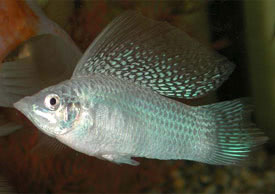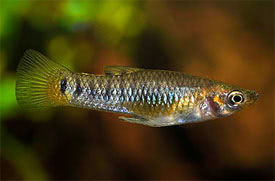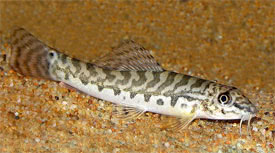
 Magyarul / Hungarian
Magyarul / Hungarian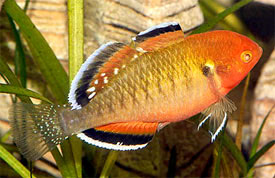
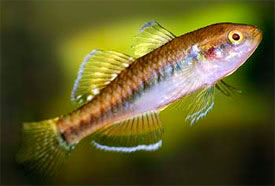
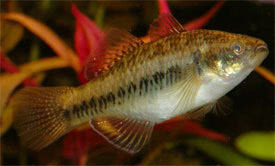
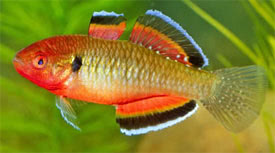
- Scientific name: Hypseleotris compressa
- Synonyms: Eleotris compressus
- Common name: Empire Gudgeon
- Group: Brackish fishes
- Habitat: Australia and Papua New Guinea
- Size: 12 cm
- Biotope: Juveniles inhabit in estuaries and coastal waters, while mature fish prefer freshwater.
- Social behavior: Not especially aggressive, but will eat smaller fish, that fit in its mouth. Keep in a species tank or associate with other gobies in a brackish community aquarium.
- Diet: Omnivorous; In nature they eat small crustaceans and insect larvae, while in aquarium they quite unfussy and will accept most dried and frozen foods.
- Breeding: Very rare in auqarium
- Tank: Minimum 70 litres
- Population: 1 pair for 150 litres
- Decoration: Provide a bottom of sand or fine-grained gravel, offer some hiding places of stone. Smooth rocks, roots, or branches are ideal decoration. The aquarium can be planted if freshwater is used, but the choice of plants becomes problematic if the animals are kept in brackish water.
- Temperature: 20-30 °C
- pH: 7-8,5
- Hardness: 15-30 NK°
- Lifespan: 5-8 years
Description: Hypseleotris compressa has a compressed head and a slender, elongated body, deepening with growth. Two dorsal fins present. The dorsal and anal fins are red in the breeding male with a black and white band, while these fins are olive-brown in the female. Empire Gudgeon is able to survive in both pure freshwater and full marine conditions over a wide range of temperatures.
The male is shiny red at spawning time. Even outside of spawning, male is more colorful than the female. Although it is occasionally possible to receive a spawning pair, breeding is problematic. During the courtship the male try to entice females, with his beautiful breeding colors. They will also become territorial towards rival males, until the end of the spawning season. The fish breed in freshwater in nature, so we should replicate these conditions in the breeding aquarium. Spawning occurs on pre-cleaned stones, wood or sea shells, and the number of the eggs can be 3000. They have the smallest eggs among fish (measuring only 0.32 mm in diameter). The male guards the eggs by keeping other fish away, until the tiny larvae hatch after about 24 hours (at a temperature of 25°C), and this is where the real problems begin. In nature the fry would now be carried by the currents to the sea, where they feed around the estuaries. This is almost impossible to replicate under aquarium conditions. It may be worth increasing the salinity slowly over a period of a few days until the fry are in brackish conditions in order to raise them. Because of their small size, feeding is difficult. Normal first foods, such as rotifers, infusoria, etc. are not accepted. One option may be to carefully feed algae water (green-water), but no reports have been made about a totally succesful rearing.



